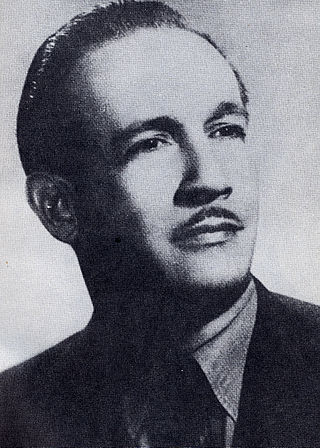Related Research Articles

The music of Mexico is highly diverse, featuring a wide range of musical genres and performance styles. It has been influenced by a variety of cultures, primarily deriving from Europeans, Indigenous, and Africans. Music became an expression of Mexican nationalism starting in the nineteenth century.

José Alfredo Jiménez Sandoval was a Mexican singer and songwriter, whose songs are considered the basis of modern regional Mexican music and rancheras. During his lifetime, he wrote over a thousand songs, which have been covered by various artists.

Chanticleer is a full-time male classical vocal ensemble based in San Francisco, California, founded in 1978. It is known for its interpretations of Renaissance music, for which they were founded, but also a wide repertoire of jazz, gospel and contemporary classical music. Its name is derived from the "clear singing rooster" in Chaucer's The Canterbury Tales. The ensemble has made award-winning recordings.

Panda was a Mexican rock band formed in Monterrey, Nuevo León in 1996 as part of the musical movement known as Avanzada Regia. The last line-up consisted in singer José Madero, drummer Jorge Vásquez, lead guitarist/Backup vocals Arturo Arredondo and bassist Ricardo Treviño.

Gualberto Antonio Castro Levario was a Mexican singer, actor and television presenter.
A voice type is a group of voices with similar vocal ranges, capable of singing in a similar tessitura, and with similar vocal transition points (passaggi). Voice classification is most strongly associated with European classical music, though it, and the terms it utilizes, are used in other styles of music as well.

The Conservatorio Nacional de Música (CNM) is a music conservatory located in the Polanco neighborhood of Mexico City, Federal District, Mexico.
Little Joy is a rock supergroup formed in 2007 by Los Hermanos singer-songwriter Rodrigo Amarante, The Strokes drummer Fabrizio Moretti, and Binki Shapiro. They released Little Joy, their only album, in 2008.
Los Freddy's were a Mexican musical group, founded in 1962 in Guadalajara, Jalisco.

Eliseo Grenet Sánchez was a Cuban pianist and a leading composer/arranger of the day. He composed music for stage shows and films, and some famous Cuban dance music. Eliseo was one of three musical brothers, all composers, the others being Emilio and Ernesto (1908–1981). Emilio went on composing even after having a leg bitten off by a shark in 1930; Ernesto was a drummer who became leader of the Tropicana's orchestra.
La Carabina de Ambrosio is a Mexican television show created and developed by Humberto Navarro, filmed at the Televisa Studios, Chapultepec in Mexico City, from 1978 until 1987. The slogan of the show was "A Magical, Comical, and Musical Variety Show." The show had guest emcees that included César Costa, Gualberto Castro, Fito Girón, and Manolo Muñoz. While the emcees sang a cast member would interrupt rudely and a comedy skit began. The show consisted of numerous skits, jokes and tricks played on the emcees. It is rumored that the reason there were so many emcees during the run of the show was due to the numerous tricks played on them.
David Záizar was a Mexican mariachi singer and actor who appeared in many Mexican films. He was active beginning in the 1940s and until his death in 1982, due to a respiratory infection. What earned him the title of "Rey del Falsete" or "King of the Falsetto" was the fact that he displaced Miguel Aceves Mejía, who had the title until Záizar's appearance on the ranchera music scene. Initially, he joined forces with his brother, Juan Záizar, with whom he formed a duo. Prior to this, they had both been working on individual projects, especially Juan, who was a renowned composer and singer. They had only sung together for very special occasions, like their tribute to honor the famous ranchera composer, also from Jalisco, Pepe Guízar. Out of this union came the famous duo, "Los Hermanos Záizar". Like most Mexican folk songs, the majority of those interpreted by David that we have left today are about lost loves, unfaithful women, Mexico and its people, and several other topics commonly present throughout ranchera music.
María Elena Saldaña, also known as La Güereja, is a Mexican television actress whose career dates back to the mid-1980s. Saldaña, who is a little person, has achieved fame over the years with her portrayal of a little Mexican girl named Mariquita Castro Pérez.
Arturo Castro Rivas Cacho was a Mexican character actor who was often credited and nicknamed as "El Bigotón," due to his distinctive mustache.
Arturo "Benito" Castro Hernández was a Mexican musician, actor, comedian, and a member of Los Hermanos Castro.

Sonora Santanera is an orchestra playing tropical music from Mexico with over 60 years of history. Modeled after an earlier Cuban band called Sonora Matancera, the Sonora Santanera was founded in 1955 by Carlos Colorado in the state of Tabasco, and went on to find enormous success during the 1960s. In 1960, comic actor Jesús “Palillo” Martínez helped the band play in Mexico City and get a professional record deal under the name of Sonora Santanera. From that time until 1986, the band changed members, but remained focused on Carlos Colorado, the sole musical arranger for the group. Colorado died in a bus accident in 1986, causing some members to split off and form another orchestra called Los Santaneros. The remaining members changed name to Internacional Sonora Santanera. Since the 1980s, little of the band's sound changed although members continued to do so. In the 2000s, more bands appeared using the name of Sonora Santanera as part of their names, leading the orchestra to pursue legal actions and another name change in 2007 to the current name Sonora Santanera de Carlos Colorado.
Pacific Mambo Orchestra is a Latin dance music orchestra based in the San Francisco Bay Area.
Óscar Guillermo Avilés Arcos was a Peruvian guitarist, singer, and composer.
Judy Blair is an American musician, singer, piano and Hammond B3 organ player, a composer of jazz, blues, rhythm & blues and boogie music. She is a Hammond organ virtuoso whose musical career began in the United States in the 1960s and continues in France where she has lived since 1994. She has recorded four solo albums.

Rostros Ocultos is a Mexican rock-pop band founded in 1985, who were moderately well known in the 80s. It was part of the post-movement started by Caifanes, and it was one of the bands that followed its principles, along with Santa Sabina, Neón, Fobia, El Tri, Kerigma and Maná, among others.
References
- ↑ "Hits of the World". Billboard . 17 June 1967. p. 49. Retrieved 10 June 2010.
- ↑ Ortiz, Enrique (1 January 1972). "From the music capitals of the world". Billboard . p. 27. Retrieved 10 June 2010.